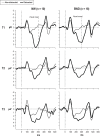Sleep loss, circadian mismatch, and abnormalities in reorienting of attention in night workers with shift work disorder
- PMID: 24587577
- PMCID: PMC3920320
- DOI: 10.5665/sleep.3494
Sleep loss, circadian mismatch, and abnormalities in reorienting of attention in night workers with shift work disorder
Abstract
Study objectives: Permanent night-shift workers may develop shift-work disorder (SWD). In the current study, we evaluated neurophysiological and behavioral indices of distractibility across times prior to the night shift (T1), during night hours (T2), and after acute sleep deprivation (T3) in permanent hospital night workers with and without SWD.
Methods: Ten asymptomatic night workers (NW) and 18 NW with SWD participated in a 25-h sleep deprivation study. Circadian phase was evaluated by dim-light salivary melatonin onset (DLMO). Objective sleepiness was evaluated using the Multiple Sleep Latency Test (MSLT). Electrophysiological distractibility was evaluated by brain event-related potentials (ERP), whereas behavioral distractibility was evaluated by performance on a visual task in an auditory-visual distraction paradigm.
Statistical analyses: Comparisons of ERP results were performed by repeated-measures analysis of variance, and t-tests were used where appropriate. A Mann-Whitney U test was used for comparison of variables (MLST, Stanford Sleepiness Scale, and DLMO) that deviated from normal.
Results: First, in the SWD group, the reorienting negativity ERP amplitude was significantly attenuated compared to that in the NW group. Second, the SWD group had shorter MSLT during night shift hours (4.8 ± 4.9 min) compared to that in NW (7.8 ± 3.7 min; U = 47; z = -2.1; P < 0.03). Third, NW with SWD had a DLMO at 20:27 ± 5.0 h, whereas healthy NW had a DLMO at 05:00 ± 3.4 h (U = 43.5; z = -2.22, P < 0.03). Finally, acute sleep deprivation impaired behavioral performance and the P3a ERP in both groups.
Conclusions: Our results demonstrate specific deficits in neurophysiological activity in the attentional domain among the shift-work disorder group relative to night workers.
Keywords: ERPs; Shift work disorder; circadian phase; distractibility.
Figures








Similar articles
-
Circadian phase, sleepiness, and light exposure assessment in night workers with and without shift work disorder.Chronobiol Int. 2012 Aug;29(7):928-36. doi: 10.3109/07420528.2012.699356. Chronobiol Int. 2012. PMID: 22823876
-
Differential sleep, sleepiness, and neurophysiology in the insomnia phenotypes of shift work disorder.Sleep. 2015 Jan 1;38(1):119-26. doi: 10.5665/sleep.4336. Sleep. 2015. PMID: 25325466 Free PMC article.
-
Length polymorphism in the Period 3 gene is associated with sleepiness and maladaptive circadian phase in night-shift workers.J Sleep Res. 2015 Jun;24(3):254-61. doi: 10.1111/jsr.12264. Epub 2014 Dec 29. J Sleep Res. 2015. PMID: 25545397
-
Impacts of shift work on sleep and circadian rhythms.Pathol Biol (Paris). 2014 Oct;62(5):292-301. doi: 10.1016/j.patbio.2014.08.001. Epub 2014 Sep 20. Pathol Biol (Paris). 2014. PMID: 25246026 Review.
-
Understanding and diagnosing shift work disorder.Postgrad Med. 2011 Sep;123(5):96-105. doi: 10.3810/pgm.2011.09.2464. Postgrad Med. 2011. PMID: 21904091 Review.
Cited by
-
Insomnia in shift work disorder relates to occupational and neurophysiological impairment.J Clin Sleep Med. 2015 Apr 15;11(4):457-65. doi: 10.5664/jcsm.4606. J Clin Sleep Med. 2015. PMID: 25665690 Free PMC article.
-
Recovery sleep attenuates impairments in working memory following total sleep deprivation.Front Neurosci. 2023 Apr 18;17:1056788. doi: 10.3389/fnins.2023.1056788. eCollection 2023. Front Neurosci. 2023. PMID: 37144096 Free PMC article.
-
Faculty development committee: Evolution through engagement and empowerment.AEM Educ Train. 2025 Apr 29;9(Suppl 1):S66-S72. doi: 10.1002/aet2.70017. eCollection 2025 Apr. AEM Educ Train. 2025. PMID: 40308869 Free PMC article.
-
Working with poor sleep.Sleep. 2014 Sep 1;37(9):1401-3. doi: 10.5665/sleep.3978. Sleep. 2014. PMID: 25142563 Free PMC article. No abstract available.
-
Psychosocial Features of Shift Work Disorder.Brain Sci. 2021 Jul 14;11(7):928. doi: 10.3390/brainsci11070928. Brain Sci. 2021. PMID: 34356162 Free PMC article.
References
-
- Purnell MT, Feyer AM, Herbison GP. The impact of a nap opportunity during the night shift on the performance and alertness of 12-h shift workers. J Sleep Res. 2002;11:219–27. - PubMed
-
- Lockley SW, Cronin JW, Evans EE, et al. Effect of reducing interns' weekly work hours on sleep and attentional failures. N Engl J Med. 2004;351:1829–37. - PubMed
-
- Suzuki K, Ohida T, Kaneita Y, et al. Mental health status, shift work, and occupational accidents among hospital nurses in Japan. J Occup Health. 2004;46:448–54. - PubMed
-
- Dula DJ, Dula NL, Hamrick C, Wood GC. The effect of working serial night shifts on the cognitive functioning of emergency physicians. Ann Emerg Med. 2001;38:152–5. - PubMed
-
- Folkard S, Tucker P. Shift work, safety and productivity. Occup Med (Lond) 2003;53:95–101. - PubMed
Publication types
MeSH terms
Substances
Grants and funding
LinkOut - more resources
Full Text Sources
Other Literature Sources

